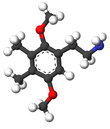2C-G

| |||
| |||
| Names | |||
|---|---|---|---|
| Preferred IUPAC name 2-(2,5-Dimethoxy-3,4-dimethylphenyl)ethan-1-amine | |||
| Identifiers | |||
| CAS Number | |||
| 3D model (JSmol) | |||
| ChEMBL | |||
| ChemSpider |
| ||
| PubChem CID | |||
| UNII | |||
| CompTox Dashboard (EPA) | |||
InChI
| |||
SMILES
| |||
| Properties | |||
| Chemical formula | C12H19NO2 | ||
| Molar mass | 209.289 g·mol−1 | ||
| Except where otherwise noted, data are given for materials in their standard state (at 25 °C , 100 kPa).
| |||
2C-G is a psychedelic phenethylamine of the 2C-series. First synthesized by Alexander Shulgin, it is sometimes used as an entheogen. It has structural and pharmacodynamic properties similar to 2C-D and Ganesha. Like many of the phenethylamines in PiHKAL, 2C-G and its homologs have only been taken by Shulgin and a small test group, making it difficult to ensure completeness when describing effects.
Chemistry
2C-G is 3,4-dimethyl-2,5-dimethoxyphenethylamine, with the formula C
12H
19NO
2.
Dosage and effects
In Shulgin's book PiHKAL, the dosage range is listed as 20 to 35 mg. Effects are similar to the related Ganesha, and are extremely long lasting; the duration is 18–30 hours. Visual effects are muted or absent, and it is described in PiHKAL as an "insight-enhancer". Unlike other members of the 2C-series, 2C-G is nearly as potent as its amphetamine form.
Homologs
Several homologs of 2C-G were also synthesized by Shulgin. These include 2C-G-3, 2C-G-5, and 2C-G-N. Some, such as 2C-G-1, 2C-G-2, 2C-G-4, and 2C-G-6 are possible to synthesize in principle but impossible or extraordinarily difficult to do so in practice.
| 2C-G-1 | CAS: 2888537-47-9 The synthesis of this compound has not been reported, but it is described prophetically in WO2022271982 |
 2C-G-1 2C-G-1
|
| 2C-G-2 | CAS: 2888537-48-0 The synthesis of this compound has not been reported, but it is described prophetically in WO2022271982 |
 2C-G-2 2C-G-2
|
| 2C-G-3 | CAS: 207740-19-0 Dosage: 16–25 mg |
 2C-G-3 2C-G-3
|
| 2C-G-4 | CAS: 952006-59-6 Synthesized but not tested. |
 2C-G-4 2C-G-4
|
| 2C-G-5 | CAS: 207740-20-3 Dosage: 10–16 mg |
 2C-G-5 2C-G-5
|
| 2C-G-6 | CAS: 2888537-49-1 The synthesis of this compound has not been reported, but it is described prophetically in WO2022271982 |
 2C-G-6 2C-G-6
|
| 2C-G-N | CAS: 207740-21-4 Dosage: 20–40 mg |
 2C-G-N 2C-G-N
|
Legal status
Canada
As of October 31, 2016; 2C-G is a controlled substance (Schedule III) in Canada.
United Kingdom
2C-G and all other compounds featuring in PiHKAL are Class A drugs in the United Kingdom.
United States
In the United States 2C-G is considered a Schedule 1 controlled substance as a positional isomer of 2C-E and 2,5-Dimethoxy-4-methylamphetamine (DOM).
See also
References
- ^ a b c PiHKAL entry on 2C-G
- ^ "Regulations Amending the Food and Drug Regulations (Part J — 2C-phenethylamines)". 4 May 2016.
- ^ "Lists of: Scheduling Actions - Controlled Substances - Regulated Chemicals" (PDF). Drug Enforcement Administration. February 2023.
External links
- , , , PiHKAL entries on the homologues
- 2C-G Entry in PiHKAL • info
- 2C-G-3 Entry in PiHKAL • info
- 2C-G-4 Entry in PiHKAL • info
- 2C-G-5 Entry in PiHKAL • info
- 2C-G-N Entry in PiHKAL • info

